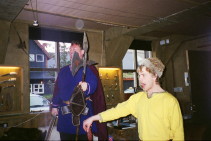 Photo.
Photo. Vikings from Iceland.
According
to the Touch & Turn`s website (
www.touchandturn.com) is their
mission to develop and validate an online platform for mediation of
digitised books and manuscripts, creating a network in which the most impressive
possessors of literary rarities in Europe take part.
The Internet
opens up new possibilities for the exchange of digital copies between different
institutions. Touch and Turn has initiated the project "
Mediation of rare
books over the Internet", involving libraries and museums from five
European countries.
The project was begun in 2003 and is co-funded by the European eTEN programme
designed to facilitate the deployment of telecommunications network-based
services (e-services) with a trans-European dimension.
The project involves eight partners from Austria, Germany, Greece, Italy and
Sweden that have digitised items from their collections using T&T
technology. The project partners are:
- Karl-Franzens University Library in Graz, Austria
- Zentral und
Landesbibliothek Berlin, Germany
- Swedish Institute at Athens, Greece
-
University Library of Crete, Greece
- Baldini Library, Italy
-
Keats-Shelley Memorial House, Italy
- National Library of Rome, Italy
-
Uppsala University Library, Sweden
A common theme for choosing books was travel, demonstrating the historical
impact of interaction among people sharing and observing customs, traditions and
languages. The collection is an impressive representation of European cultural
heritage throughout the centuries.
One of the books is written by Snorri Sturluson (1179-1241), manuscript, 14th
Century, Uppsala University Library. This work, also called the Prose Edda or
Younger Edda, was written in Iceland at the beginning of the 1300-century. It
was intended as a guide to scaldic poetry and its different parts deal with Old
Norse mythology ( Gylfaginning), the art of literary diction (Skáldskaparmál)
and various meters (Háttatal). In the two parts the author is quoting several
stanzas from the Poetic, also called the Elder Edda. The main part of the last
section is a poem written by Snorri himself.
There are three fairly complete known medieval copies of Snorri's Edda, of
which the Uppsala Edda is considered to be the oldest.
It is believed to have originated in western Iceland in the early 1300s. The
text of the manuscript differs substantially from all the others; among other
things, many of the stanzas given as examples are missing. The manuscript was
given in 1639 by the Icelandic bishop Brynjólfur Sveinsson to the Danish
collector Stephanus Johannis Stephanius. Stephanius's widow sold it and several
other manuscripts to Magnus Gabriel De la Gardie; it thus came to be included in
the latter's donation to the Uppsala University Library in 1669.
The text of the manuscript is neatly and distinctly written. Most of the
drawings of human figures that appear sporadically are quite simple; they are
considered to have been made after the writing of the text. The most famous
drawing covers all of page 50 and is believed to originate from the fourteenth
century.
It illustrates the frame story of Gylfaginning: King Gylfe of Svitiod
(Sweden) comes in disguise to Asgard, where he meets, conjured up by the Æsir, a
"trinity" of chieftains: Hár, Jafnhár and Þriði (High One, Just-as-High and
Third). The illustration shows the three men sitting on three thrones,
placed above each other. In answer to his questions about the world and the
gods, Gylfe is told by them large parts of the stories of Old Norse
mythology.
With this old book as background information, it`s
only make it more exciting to travel to Iceland and Norway. There are
still some Vikings left in these countries, but don`t worry. Their behaviour is
adjusted from thousand years ago.
Stein Morten Lund, 25 April 2004
Additional information
The company Touch &
Turn is currently developing it`s online shop.
For information and order: info@touchandturn.com
Website:
www.touchandturn.com
Facts about
Iceland:
Formal country name: Republic of
Iceland.
Area: 103,000 sq
km.
Population:
281,000.
Capital
City:
Reykjavik.
People: 97%
Icelanders.
Language:
Icelandic, English.
Religion: 95%
Evangelical Lutheran, 3% other Protestant denominations, 1% Roman Catholic,
& some followers of Ásatrú, an ancient Norse religion
Government:
constitutional republic.
Facts about
Norway:
Formal country name: Kingdom of
Norway.
Area: 324,220 sq
km.
Population: 4.54
million.
Capital
City:
Oslo (pop
508,730).
People: 97%
Nordic, Alpine & Baltic, with a Sami minority.
Language:
Norwegian Bokmål, Norwegian Nynorsk, Northern Sami.
Religion:
Christian (86.3% Evangelical Lutheran).
Government:
constitutional monarchy.
